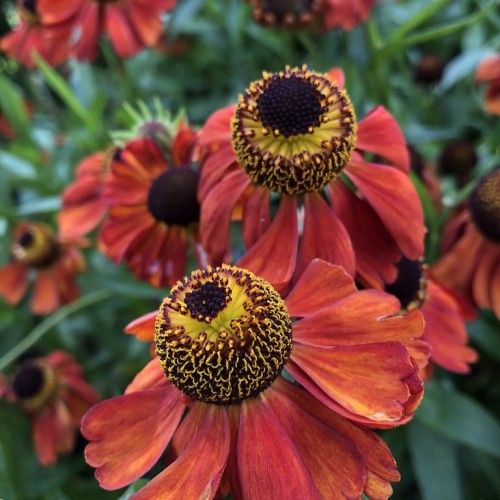
sneezeweed
Helenium autumnale 'Balsaluemb' SALUD EMBERS
Cycle:
Herbaceous Perennial
Watering:
Frequent
Hardiness Zone:
4 - 9
Flowers:
Flowers
Sun:
Full sun
Leaf:
Yes
Growth Rate:
Low
Maintenance:
Moderate
Drought Tolerant:
Yes
Salt Tolerant:
Yes
Care Level:
Medium
watering
Sneezeweed should be given ample water throughout the growing season. It should be watered at least once per week, and more frequently during periods of high heat. During periods of extreme heat or drought, this plant may need to be watered multiple times per week. To ensure the soil is evenly moist, water every 2 to 3 days until the top 6 inches of soil is evenly moist. During colder and wetter months, water less frequently. The soil should never be soggy or saturated. As a general rule, water when the top inch of soil is dry.
sunlight
Sneezeweed (Helenium autumnale 'Balsaluemb' SALUD EMBERS) prefers full sun and benefits from at least 6 hours of direct sunlight per day. As the plant matures, it can tolerate up to 8-10 hours of direct sunlight each day. However, too much direct sunlight may result in scorching of the leaves. It's best to plant it in a location where the sun level can be adjusted based on the season. In the hot summer months, the plant may benefit from some afternoon shade, while during the winter its preference may be for more direct sunlight.
pruning
Sneezeweed (Helenium autumnale 'Balsaluemb' SALUD EMBERS) should be pruned back in early spring, just before or after new growth begins. This should be done when the plant is still dormant to ensure the removal of dead foliage and encourage vigorous growth. Prune the outer edges of the plant to about 1/3 of its previous height, and cut back any flower stems that have already formed. This will encourage the growth of multiple new stems, resulting in a bushier form. In addition, cut any weak or overcrowded stems, as well as any dead or diseased material.
Propagation
Season
Hardiness Map
FAQ
Are Sneezeweed flowers suitable for bouquets?
Sneezeweed flowers are not typically used for bouquets due to their large size and bushy shape. The flowers are usually dried and used in other craft projects or for medicinal purposes. If you wanted to use dried Sneezeweed in your bouquet, they would provide a unique and eye-catching contrast against the other greenery in the bouquet.
Should Sneezeweed be planted in groups or individually?
Sneezeweed should be planted in groups, as groupings of this flower look the best in the garden. Planting them in groups will not only make them look more appealing but will also provide helpful cover for its shallow roots. Additionally, planting them in large groupings can help it to attract pollinators like butterflies and bees, providing a habitat where they can feed off the nectar-filled blooms. For best results, it's suggested to plant groupings of three to five plants for a lush, full look.
Is Sneezeweed resistant to deer damage?
Sneezeweed is a perennial flower with a resiliency to deer damage. It has a hairy leaf texture which deters deer from browsing on it and it produces a strong aroma that most deer tend to stay away from. The stems of the plant are also relatively tough, and not easily broken off. All in all, it is considered to be deer-resistant, but not completely deer-proof. It's important to monitor the plant to make sure it is not being overbrowsed and to take steps to protect it, if necessary.
Could Sneezeweed be grown as a cut flower crop?
Yes, sneezeweed can be grown as a cut flower crop. It is an attractive and abundant flower that has a daisy-like bloom. These flowers come in a variety of colors like yellow, orange, white, and burgundy. They are striking flowers with large, paper-like petals. They can be grown in full sun to partial shade and they prefer moist soil and regular watering. Sneezeweed flowers can be harvested for bouquets and other floral arrangements, and their cheerful blooms can brighten up any home or garden.
Do Sneezeweed plants require staking?
Sneezeweed plants do not typically require staking as they have quite sturdy stems that can easily hold their own weight. Depending on the size of the plant and the growing conditions, it is possible that staking may be needed to keep it upright. However, since the plant stems are so strong and rigid, it is typically not necessary.
Is Sneezeweed a good choice for erosion control?
Yes, Sneezeweed can be a good choice for erosion control. It is a vigorous, economical low maintenance plant with deep roots that make it ideal for quick soil stabilization and improved water quality. Its flat-topped blossoms provide cover for wildlife, making it a popular choice for natural areas. The plant's quick growth and large, thick foliage make it great for reducing erosion on slopes, shores, and other areas where fast-growing, hardy plants are desired.
Are there different varieties of sneezeweed?
Yes, there are different varieties of sneezeweed. Sneezeweed is a flowering plant in the daisy family, also known as Helenium. It produces yellow, red, orange, bronze and purple flowers from July to October. There are numerous species of sneezeweed; some of the most popular types are 'Mardi Gras', 'Autumnale', 'Red Rubin', 'Tahoka Daisy' and 'Kobold'. Each variety of sneezeweed is unique in its coloring, flower size and flowering period.
